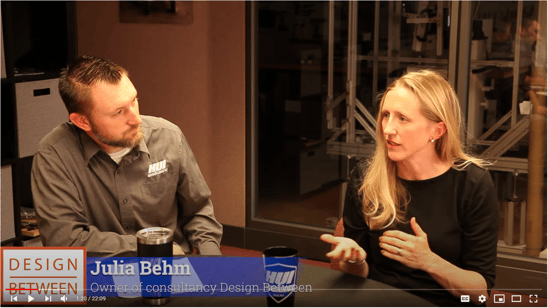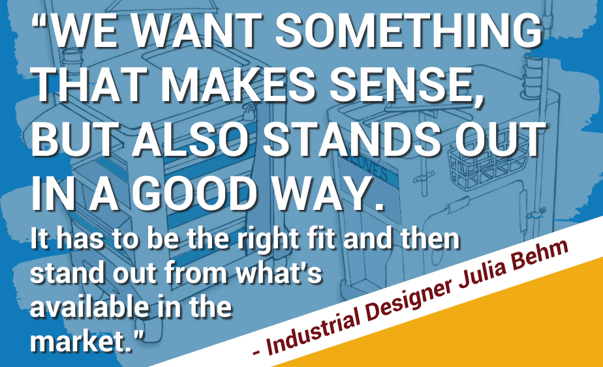An Interview with Julia Behm of Design Between
Julia Behm is a Wisconsin-based industrial designer with over 20 years of experience. At HUI, we've been lucky to collaborate with Julia for several years: first as a project manager at our company, and more recently as our go-to industrial designer for custom medical cart designs. We sat down with Julia Behm to learn more about her process for designing medical cart concepts. Julia had lots of great insights to share about industrial design for the medical industry, and the relationship that she has with our Product Development Manager Mark Collins and our engineering team.
Nick: Julia, tell us about your career with HUI, in terms of maybe from when you started to where you are today with us. Give the audience an idea of the work you've done with us.
Julia: Actually, when I came to HUI, I was hired in project management and at the time HUI was doing a lot of industrial product design and a little bit of medical product design. I came into the project management side of things with some experience from larger companies that were doing stage-gated processes and brought some of that here. And when I saw what was happening with the medical design, I got very excited because that was a big opportunity for an industrial designer to do something with more style, and some real functional challenges… something you could really sink your teeth into.

Nick: One thing that may be interesting for our audience to understand is the point in our process when you become involved as an industrial designer. Once a project is underway, we will often transition into a concept stage and that's where we get involved with you. From there, we will have an initial kickoff meeting. I think it would be really helpful for our audience to hear more about that. What do they need to bring to the table to make that kickoff meeting a success?
Julia: One of the processes that we've developed -- the features and functions document -- helps to kind of layout what those initial requirements might be, and that can be really helpful. When you first start, you're dealing with a core group of people [on the customer side] that really understand the technology and come from different specialties inside that company. Or maybe just one individual that has a really deep understanding of what the product requirements are. So, we start to gather requirements with the features and functions [document], and with a cross-functional team from HUI.
But, depending on the complexity of the system, we might also recommend some additional either design research or ethnographic research so that we can look for problems. You're really doing more of, like, “problem-finding” than “problem-solving” in that first stage. We might look at the surgical field and see if we can make observations about what they're doing that they don't even realize!
In one case, we did a surgical observation where they were taking the canister of the biomaterial and putting it on a window sill. I said: “Why are you doing that? Why is that? Tell me about what you're doing here.” And [we] discovered there [was] not a place to put it on the cart. So, if you can take that [observation], you can find a way to make just a simple metal bracket or something that gives that system more functionality in a way that's cost-effective. It sometimes feels like you're putting a lot of additional cost into a project when you're doing the research, but it can serve your end product really well.
Download our "Medical Cart Features and Functions Worksheet" to help you prepare for the medical cart design discovery process.
Nick: I'm also always amazed that when we have those features and functions meetings, you will take that information and come back with three to five concepts. Yet there's nothing visually laid out for you -- all you've done is really interviewed them and gathered some ideas. How do you go from taking that information and come to the table of three to five concepts? What’s that secret?
Julia: I think it is a lot of understanding and waiting to solve [problems]. I'm not putting pen to paper until I really understand what the needs are. So, it's very helpful when the right people and the right information come in at the very beginning. I'll do my own competitive research to see how we can differentiate the look of it and make [the product] look like something that fits in their brand family, and that makes sense aesthetically in that environment. [We want something] that makes sense, but also stands out in a good way. You don't want it to be tacky or too “space-age-y” in something that's maybe a little bit more of a subdued type of environment, like a nursing home or something. So, it has to be the right fit and then stand out from what's available in the market.
Chuck: Julia you had mentioned the “right people in the room”. So, for our OEM device manufacturer readers, when they go through product development, who are some of those "right people" that need to be there?
Julia: It's usually marketing, engineering, and everybody that would typically be there, but it can be helpful to see people that might not be in that room. Like, where's the customer service person that can tell us about the common replacement parts, or things that are failing in the field? Or even the guy or girl that's loading the truck -- where are they grabbing the product, how are they touching it, and how is that impacting them? Those little things. If you can talk to more people in the beginning, you can create some really nice pieces of innovation.

Nick: I want to transition over to the relationship between Mark and Julia. Mark is our applications engineer at HUI, and when it comes to solving problems or when we have complex situations within a product, Mark really brings that expertise to help bring the industrial design into the engineering perspective. So I'd like to spend a little bit of time talking about that relationship and how the two of you work together.
Mark: Sometimes it’s kind of challenging because I've always kind of looked upon my job as, you know, making Julia's dreams come true. Whatever she can imagine on paper… I have to think sometimes quite a bit just to figure out how to make that happen. So there's a lot of back-and-forth, I would say. You know the biggest, the most amazing part of the process is -- I think -- when we do it really fast. Where we end up coming to a concept meeting, and there are five concepts that we show them and then we have a “mix and match” right away. It blows my mind. You're the fastest industrial design I've ever seen. Like, we will be alone in a room for three, four hours, and you'll take the feedback that you got and transform that… into a final concept or two final concepts. And I'm kind of curious on your perspective of that -- do you enjoy that, Julia?
Julia: Oh I do! I love it, actually. That's like, the fun part, right? And I think it's really good as an industrial designer... I don't want to put things out there into the world that don't work right. So it's good. It's kind of an ideal situation for me to work with talented engineers who can give [me] confidence that those types of mechanisms, that they will work [in the final design]. You're creating form and function kind of at the same time, and it does happen really fast. When you're brainstorming, and sketching, and putting that in the computer, and then you can show [the customer]. If you have decision-makers in the room? I mean, it goes like that (snaps fingers).
Nick: So, Julia, from your perspective in working with engineers… What's the most frustrating thing that they bring to the table?
Julia: I don't know... I think it's hard to see companies skip design. I think that is hard. Because I know that we could do it just a little better if they would give us like a half a chance. You know, make it a little bit softer on the edges, [with] different material choices and things. And I know that engineering can take and fulfill that functionality amazingly, but you want to see it done in a way that's also touch-friendly, and aesthetically pleasing. So, I admire the functionality that engineers bring to the table, but you know it needs to be the "three corners". It's got to have the aesthetics, and the cost considerations and the functionality all together to be a “good” design for me.
Curious about how functionality impacts design in medical carts?
Download our "Insiders Guide to Medical Cart Aesthetics"
Julia Behm is the owner of Wisconsin-based industrial design consultancy Design Between. She holds a degree in Industrial Design from the University of Cincinnati and has designed for major manufacturers in a variety of industries.
If you'd like to learn more about Julia and her work, you can check out the Design Between website at www.designbetween.com or find her on LinkedIn.
To see our in-depth interview with Julia and Mark, check out Episode 6 of our YouTube series "What's Up with Nick and Chuck"!
